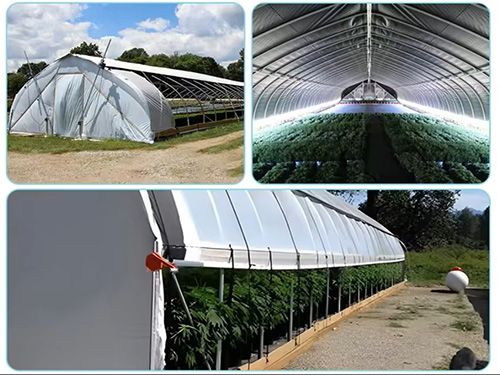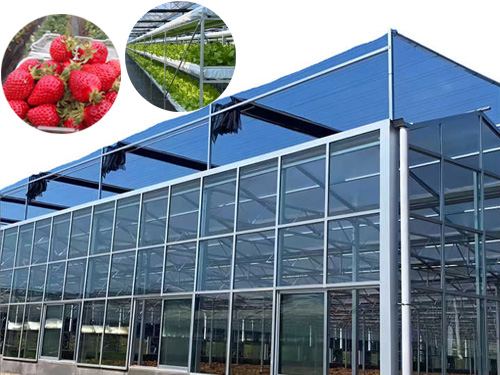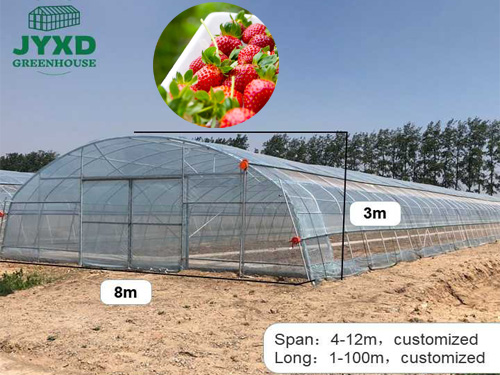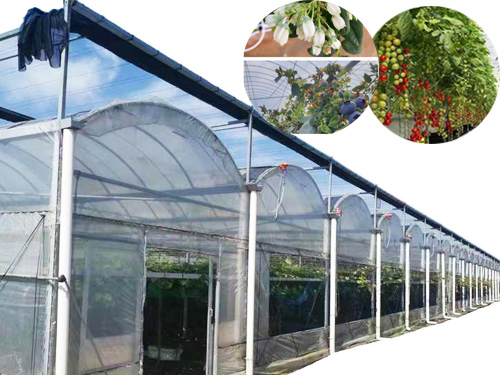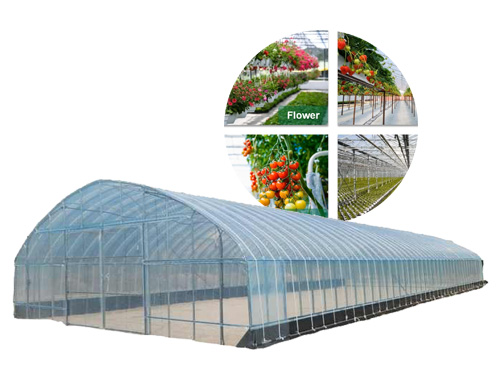NEWS DETAILS
NEWS INFORMATION
Hydroponic vs. Soil-Based Greenhouse Systems: Choosing the Best Method
AUTHOR:jyxd-greenhouse DATE:2025-03-11 16:20:30 HITS:55
As greenhouse farming continues to grow in popularity, growers face the critical decision of choosing the right growing system for their crops. Two primary options for greenhouse cultivation are hydroponic systems and soil-based systems. Each method offers unique advantages and challenges, and the choice between the two depends on various factors such as crop type, available space, water resources, and long-term goals. This article explores the key differences between hydroponic and soil-based greenhouse systems, helping you make an informed decision on which method is best suited for your needs.
1. What is Hydroponics?
Hydroponics is a soilless growing system that uses a nutrient-rich water solution to deliver essential nutrients directly to the plant roots. Plants grow in a variety of mediums like perlite, vermiculite, or coconut coir, which support the plants and allow the roots to absorb the nutrients in the water. Hydroponic systems offer several advantages, especially in environments where soil quality is poor or unavailable.
Types of Hydroponic Systems
There are several types of hydroponic systems, each with its own set of benefits:
• Nutrient Film Technique (NFT): A thin film of nutrient solution flows over the roots, providing consistent access to water and nutrients.
• Deep Water Culture (DWC): Plant roots are submerged in a nutrient solution, offering a continuous supply of nutrients and oxygen.
• Aeroponics: Roots are suspended in the air and misted with nutrients, allowing for high oxygen levels and fast growth.
• Wick System: Nutrients are delivered to the plant roots via a wick, which draws water from a reservoir.
Each system varies in complexity, cost, and suitability for different crop types.
2. What is Soil-Based Greenhouse Cultivation?
Soil-based greenhouse systems are the traditional method of growing crops in greenhouses. In this system, plants are grown directly in soil, which is typically enriched with organic matter, compost, and fertilizers. Soil-based systems are commonly used for growing a wide variety of crops, including vegetables, herbs, and flowers.
Advantages of Soil-Based Systems
Soil-based systems offer several key benefits, including:
• Natural Environment for Plants: Soil contains essential microorganisms and nutrients that create a natural, balanced environment for plant growth.
• Water Retention: Soil can retain moisture, reducing the need for frequent irrigation and minimizing water waste.
• Lower Setup Costs: Soil-based systems typically have lower initial investment costs compared to hydroponic systems.
3. Key Differences Between Hydroponic and Soil-Based Systems
While both systems offer unique advantages, there are several important differences between hydroponics and soil-based greenhouse systems:
Water Usage
One of the primary benefits of hydroponics is its efficient use of water. In hydroponic systems, water is recirculated, reducing water wastage. This is especially valuable in areas with limited water resources. Soil-based systems, on the other hand, may require more water, particularly if the soil has poor water retention or if over-irrigation occurs. However, soil-based systems can be more water-efficient when combined with advanced irrigation techniques like drip irrigation.
Nutrient Delivery
In hydroponic systems, nutrients are delivered directly to the plant roots via the water solution, allowing for precise control over nutrient levels. This can result in faster plant growth and higher yields. In soil-based systems, nutrients are absorbed from the soil, which can be less predictable. Soil fertility can vary depending on the quality of the soil, and it may require regular supplementation with fertilizers and organic amendments to maintain optimal plant growth.
Crop Growth and Yield
Hydroponic systems typically promote faster plant growth because the roots have direct access to all the essential nutrients in a dissolved form. This often leads to higher yields, particularly for crops like lettuce, herbs, and leafy greens. In contrast, soil-based systems can have slower growth rates, as nutrient absorption depends on soil quality and composition. However, soil-based systems can still achieve high yields, particularly when combined with high-quality soil amendments and organic farming practices.
Initial Setup and Maintenance Costs
Hydroponic systems tend to have higher initial setup costs due to the need for specialized equipment such as pumps, nutrient reservoirs, and growing mediums. However, hydroponic systems can be more efficient in terms of space usage and resource management, potentially leading to higher profits over time.
Soil-based systems, on the other hand, generally require a lower initial investment. The main costs come from purchasing soil amendments, fertilizers, and potentially upgrading the greenhouse infrastructure. Maintenance costs in soil-based systems are also typically lower, as they do not require specialized equipment or complex monitoring systems.
Space Efficiency
Hydroponic systems are more space-efficient compared to soil-based systems. Since hydroponic systems deliver nutrients directly to plant roots, plants can be grown closer together, increasing the number of crops per square foot. This makes hydroponics ideal for small spaces or urban farming. Soil-based systems, while versatile, require more space for plants to spread out and access nutrients from the soil. However, with proper management, vertical farming techniques can also be used in soil-based systems to increase space efficiency.
Environmental Impact
Both hydroponic and soil-based systems have environmental impacts, but in different ways. Hydroponic farming uses less water and can be implemented in areas with poor soil quality, but it still requires energy for pumping water and maintaining optimal conditions. Additionally, the production of hydroponic growing mediums, such as perlite or coconut coir, can have a significant environmental impact.
Soil-based systems generally have a lower carbon footprint in terms of energy usage, as they rely more on natural processes. However, overuse of synthetic fertilizers and pesticides in soil-based systems can lead to soil degradation and water pollution. Organic soil-based systems are more environmentally friendly, as they emphasize the use of compost, natural fertilizers, and sustainable practices.
4. Choosing the Right System for Your Greenhouse
The choice between hydroponics and soil-based systems depends on several factors, including:
• Crop Type: Hydroponics is ideal for crops like lettuce, herbs, and strawberries, which thrive in controlled environments and benefit from precise nutrient delivery. Soil-based systems are well-suited for a wider variety of crops, including root vegetables, tomatoes, and peppers.
• Available Space: Hydroponics is ideal for limited space due to its vertical farming capabilities. Soil-based systems may require more space for crop spread but can also benefit from vertical farming techniques.
• Budget and Resources: Hydroponic systems require a higher initial investment, while soil-based systems are more affordable to set up. However, hydroponics may offer a faster return on investment through higher yields and more efficient resource use.
• Sustainability Goals: Soil-based systems, particularly organic ones, may be more aligned with sustainability goals, as they focus on natural soil fertility and reduce dependence on external inputs. Hydroponics, though highly efficient, may require more energy and synthetic materials.
5. Conclusion
Both hydroponic and soil-based greenhouse systems offer distinct advantages, and the best method for your operation will depend on your specific needs and goals. Hydroponics is ideal for space-efficient, high-yield operations with precise nutrient control, while soil-based systems provide a natural environment for a wider variety of crops at a lower initial cost.
By carefully considering your crop types, space availability, budget, and sustainability goals, you can make an informed decision on the right greenhouse growing method for your business. Whether you opt for hydroponics or soil-based systems, both methods offer the potential for profitable and sustainable greenhouse farming.
Need help selecting the right system for your greenhouse? Contact us for expert advice on setting up your ideal growing environment.
Hebei Juyou Xinda Greenhouse Facilities Co.,Ltd.
Copyright © 2024-2025 https://www.jyxd-greenhouse.com. All Rights Reserved Hebei Juyou Xinda Greenhouse Facilities Co.,Ltd.Copyright





 Current Location:
Current Location:


